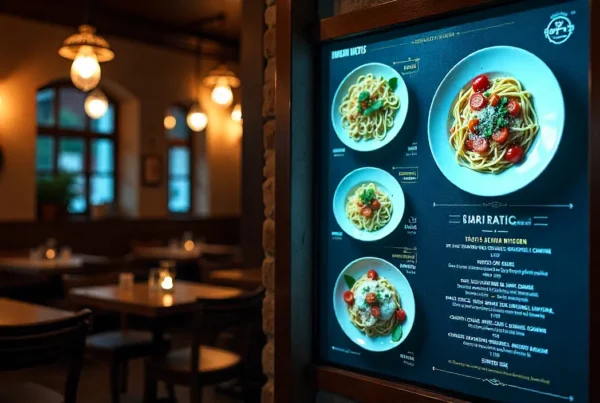Waiting rooms in a medical facility are usually full of anxiety, uncertainty, and discomfort in the high-stress environment. Hospital digital signage is a strong tool to change these stressful areas into relaxing and informational ones. With the help of digital signage in healthcare, from informative digital signage solutions for healthcare to relaxing visual displays, hospitals can go a long way in reducing the stress levels of the patients, enhancing the communication process, and ensuring a more reassuring environment for all individuals who enter the institution.
 The Stress of Hospital Waiting Rooms
The Stress of Hospital Waiting Rooms
Waiting rooms in hospitals may increase anxiety. Wait times are long and unpredictable, real-time information is not available, and the environment is sterile, all of which increases the level of stress among patients and their families. Crowding and chaotic announcements that are very loud and fragmented make it even worse. Through the implementation of digital signage in hospitals, hospitals will be able to provide clear updates, entertaining distractions and a visual atmosphere that calms instead of excites.
What is Digital Signage in Hospitals?
Digital signage in healthcare is the system of screens and displays, which broadcast dynamic content, anything, including queue updates, health education, and even serene nature scenes, and which are driven by a centralized digital signage system. These screens are controlled through digital signage software, whether it is a big lobby screen or a small digital signage hospital kiosk, and can be scheduled easily, updated remotely and can even be integrated with patient management systems.
 Benefits of Digital Signage in Hospitals
Benefits of Digital Signage in Hospitals
1. Reduced Perceived Wait Times
Interesting healthcare digital signage – such as looped nature videos, will take the mind of the patient off of the clock, which will make the wait feel shorter and less time-consuming.
2. Better Communication and Transparency
Digital signage in hospitals provides real-time status of an appointment, clinic hold-up, or procedure information and thus provides certainty and empowers patients with a clear expectation.
3. Patient Education Improvement
Digital signage solutions for healthcare industry can increase patient wellness and decrease the number of repetitive questions addressed to the staff by displaying bite-sized health tips, medication reminders, and other preventative care advice.
4. Calming Ambience
Light tones, gradual movements, and selected images of the sea or forest create a relaxing atmosphere, which are the main benefits of digital signage in hospitals in terms of emotional health.
5. Operational Efficiency
Integrating queue management with your digital signage system also reduces staff interruptions since patients get their status updates directly on the screens instead of at the nurse’s stations.
How Digital Signage Calms Patients and Families
Visual Distraction
Hospital digital signage displays of large format with panoramas or underwater pictures serve as natural relaxation aids, slightly distracting the mind away from the source of anxiety.
Reassuring Information
Notifications of future doctor availability, descriptions of the medical process, or brief messages from caregivers create an atmosphere of trust and diminish the fear of the unknown.
Children Engagement
Age-appropriate games or animated stories on the interactive digital signage in healthcare kiosks keep young patients occupied, which reduces the stress of caregivers.
Positive Messaging
Motivational quotes and patient success stories that rotate remind people of hope and give them a mood boost, showing practical results and caring.
Multilingual Support
The ability to display content in more than one language makes non-English speakers feel welcomed and informed, which is an essential feature of any effective digital signage for hospital implementation.
 Best Types of Content for Hospital Waiting Room Screens
Best Types of Content for Hospital Waiting Room Screens
- Nature & Scenic Loops: Gentle imagery of forest, beach, or gently flowing rivers with background music.
- Real-Time Queue Updates: A clear presentation of the current call numbers and wait time estimates is provided, and it helps to reduce the number of people crowding around the front desks.
- Health & Wellness Tips: Brief movies on handwashing, stress and nutrition to reinforce preventative care.
- Facility Information: Wayfinding in large campuses is supported through interactive maps, visiting hours and location of services.
- Patient Testimonials: Short videos of patients talking about how the practice helped them make them feel empathetic and reassured.
- Children’s Corner: Younger visitors to pediatric departments are occupied by educational cartoons or even easy-to-solve puzzles.
Design Tips for Calming Healthcare Digital Signage
Use a Soothing Color Palette
Choose soft blues, greens and earth tones rather than harsh reds or bright yellows to encourage relaxation.
Be Simple and Clear
Avoid cluttering. Use whitespace and minimal text and present one message or visual at a time so that it can be read at a distance.
Soft Animations & Transitions
Select gradual fades or pans instead of fast cuts and flashy effects. Not a conspicuous movement, but a kind movement.
Legible Typography
Fonts should be large, sans-serif and have high contrast on backgrounds. Make sure that the text is at least 24 points.
Soft audio support
Where sound is used, make it low-level and muted at default, with the option of activating it through headphone jacks or silent captions.
Consistent Branding
Add a touch of hospital colors and logos that establish trust but do not make screens a direct marketing tool.
How to Implement Digital Signage in Healthcare Settings
- Define Objectives: Find out whether you want to focus mainly on stress reduction, patient education, or queue management.
- Choose the right hardware: Whether it is wall-mounted televisions in waiting areas or stand-alone digital signage hospital kiosks, they should be of the right size and form factor.
- Select an Easy-to-Use Software: The software used should be able to support remote scheduling, simple content uploads and integrations with hospital systems.
- Design or Develop Content: Combine licensed relaxing images, facility-specific messages and health advice- using digital signage solutions to find healthcare content libraries where possible.
- Test & Get Feedback: Begin in one or two waiting rooms, poll patients and staff, and hone your strategy before complete implementation.
- Train Staff: Offer staff short training sessions to allow receptionists and nurses to make changes to urgent messages or emergency notices when necessary.
Real-World Examples of Calming Digital Signage in Hospitals
- Children’s Mercy Hospital, Kansas City: Deployed interactive healthcare digital signage kiosks to entertain young patients and engage them with soft animations and the perceived wait time was reduced by 40%.
- St. Mary Regional Medical Center, Reno: Installed corner-mounted digital displays with live queue information and facility maps on hospital screens, which reduced front-desk requests by 30 per cent.
- Mount Sinai Health System, NYC: Implemented panoramic nature loop videos on the lobby displays, which increased the overall patient satisfaction scores by 20 per cent.
Common Mistakes to Avoid
- Overloading Displays: There is always too much information at the same time; concentrate on one clear message.
- Stale Content: This is because failure to update health tips or queue information will rapidly diminish the trust placed on the digital signage in the hospitals.
- Overlooking Accessibility: Leaving out captions or having small fonts will leave out the visually or hearing-impaired patients.
- Noise: Unnecessary sound surges are irritating- ensure that sound is optional and low.
- Generic Messaging: A one-size-fits-all message does not capture the specific needs of pediatrics, oncology, or the emergency waiting rooms.
 Transform Your Waiting Rooms Today
Transform Your Waiting Rooms Today
Take advantage of the complete power of digital signage in hospitals to develop peaceful, informative, and efficient waiting rooms. Whether it is the high-definition presentation of nature scenes or a smooth integration of digital signage in the healthcare sector, such as queue status updates and the provision of important health tips, the Nento digital signage system provides customized digital signage solutions for healthcare sector.
To see how our platform can assist you in relieving patient anxiety, simplify operations and improve the overall guest experience at your hospital, contact Nento today because every moment of calm is a moment of healthcare.
Frequently Asked Questions
What is the purpose of digital signage in hospitals?
In healthcare, digital signage can be used to share information with patients, control queues, educate visitors and provide a calming atmosphere in waiting rooms.
How does digital signage reduce stress in waiting rooms?
It offers captivating visuals, real-time information and relaxing media that allow for avoiding anxiety cues and establishing clear expectations.
Can hospital digital signs display multilingual content?
Yes. Most digital signage solutions for healthcare allow using multiple languages, which makes non-native speakers feel more informed and comfortable.
Is digital signage in hospitals expensive to set up?
The upfront costs depend on the size of the screen and software, but ROI can be achieved by most digital signage for hospitals in two ways: patient satisfaction and operational efficiencies.
How often should content be refreshed?
Attempt to keep the queue data current and change the relaxing images every week and the health-instructional loops every month.


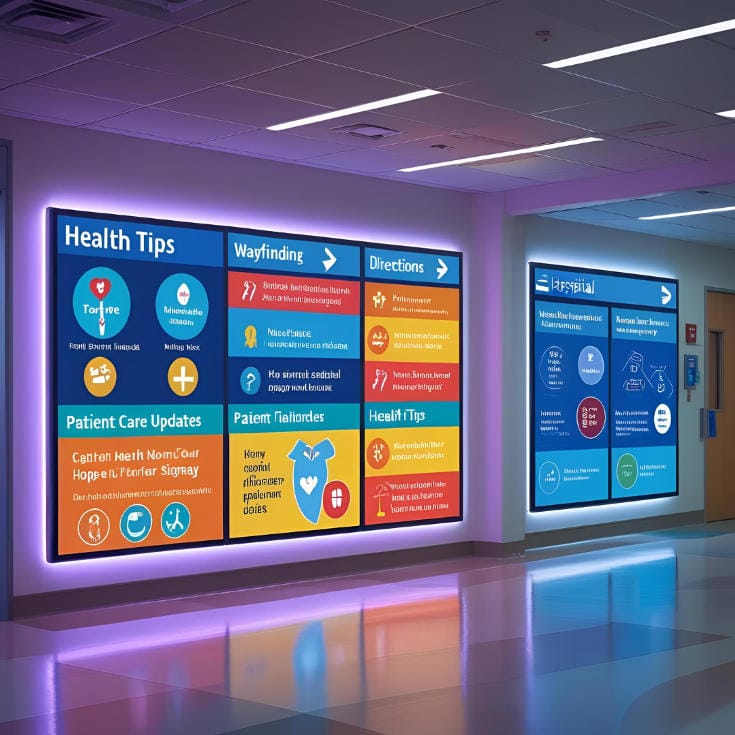 The Stress of Hospital Waiting Rooms
The Stress of Hospital Waiting Rooms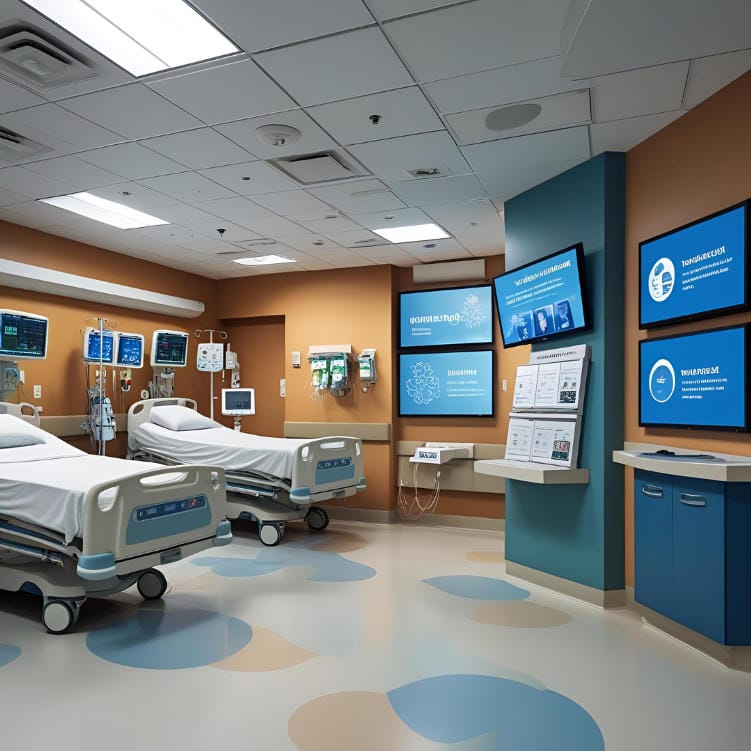 Benefits of Digital Signage in Hospitals
Benefits of Digital Signage in Hospitals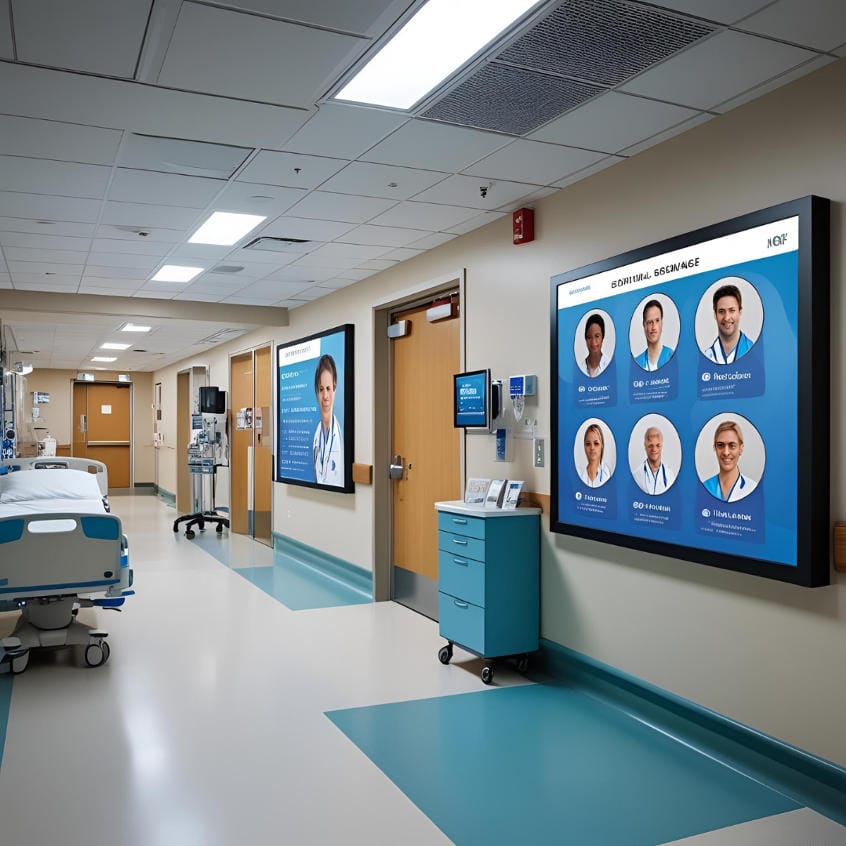 Best Types of Content for Hospital Waiting Room Screens
Best Types of Content for Hospital Waiting Room Screens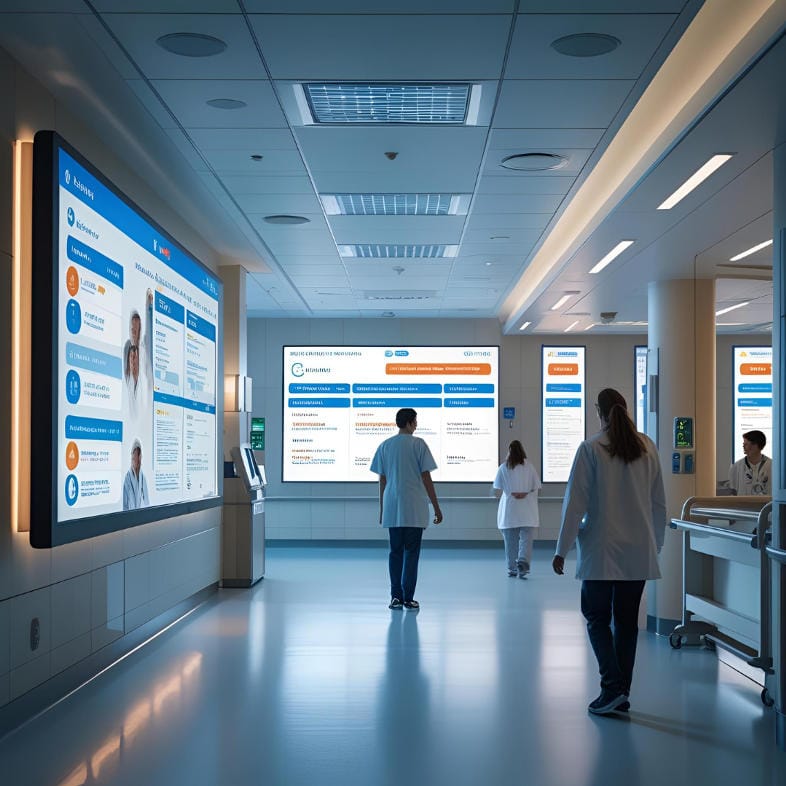 Transform Your Waiting Rooms Today
Transform Your Waiting Rooms Today